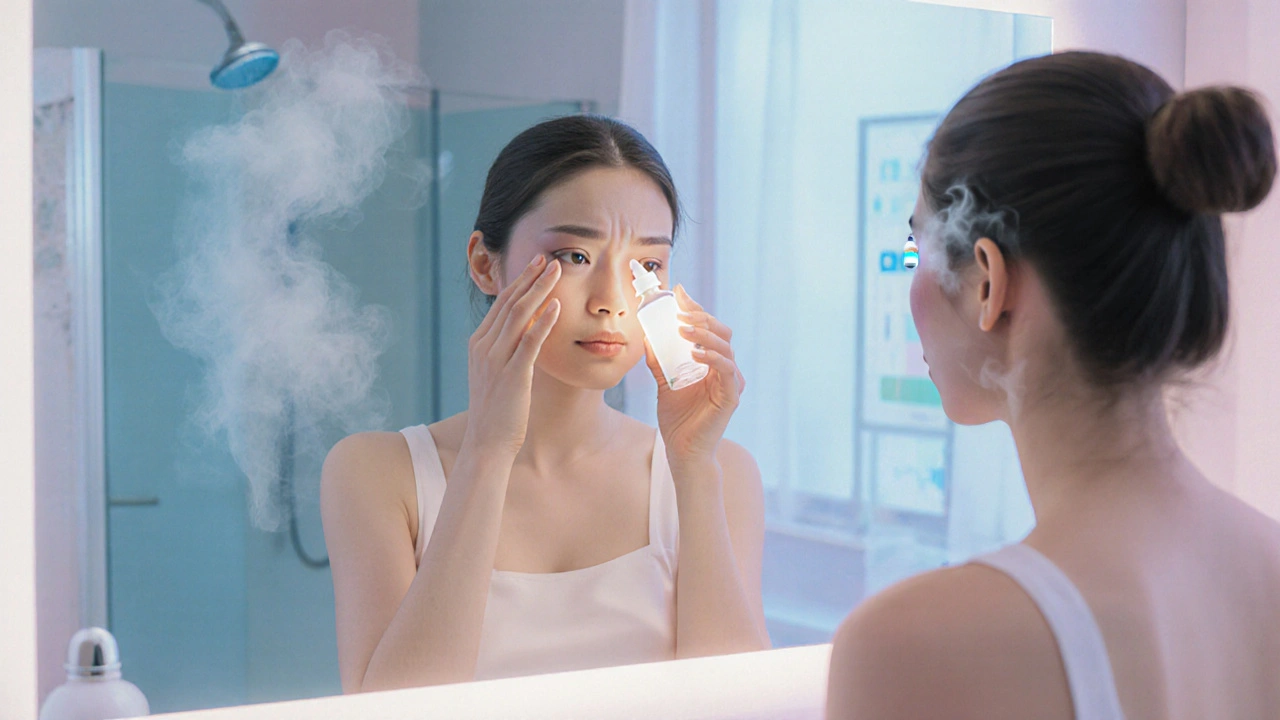Dry Eye Treatment Comparison Tool
Select Your Symptoms and Preferences
Answer the following questions to find the best dry eye treatment for you:
Cyclomune eye drops have become a go‑to prescription for chronic dry eye, but they’re not the only game in town. Below you’ll get a quick snapshot, a side‑by‑side look at the main rivals, and practical advice for picking the right bottle for your eyes.
- Cyclomune uses cyclosporine A 0.05% to calm inflammation.
- Restasis, Cequa and Xiidra offer similar or complementary mechanisms.
- Cost, dosing frequency and side‑effect profile differ markedly.
- Choosing the best option depends on disease severity, insurance coverage and personal tolerance.
What is Cyclomune Eye Drops?
Cyclomune Eye Drops is a prescription ophthalmic solution that contains cyclosporine A 0.05%. The drug works by inhibiting T‑cell activation, which reduces ocular surface inflammation-a key driver of evaporative and aqueous‑deficient dry eye. Approved by the FDA in 2024, Cyclomune is marketed for adults with moderate to severe dry eye disease who have not responded adequately to artificial tears.How Cyclosporine Treats Dry Eye
Cyclosporine is a calcineurin inhibitor. By binding to cyclophilin, it blocks the production of interleukin‑2 and other pro‑inflammatory cytokines. In the eye, this dampens the immune response that damages goblet cells and reduces tear‑film stability. Clinical trials show a 30‑40% increase in Schirmer‑type scores after 12 weeks of once‑daily use.
Top Prescription Alternatives
Three other FDA‑approved drops target the same inflammatory pathway or a complementary one.
Restasis is a cyclosporine ophthalmic emulsion (0.05%) that has been on the market since 2003. Unlike Cyclomune’s preservative‑free formulation, Restasis contains benzalkonium chloride, which can irritate sensitive eyes. Cequa delivers cyclosporine A at a higher concentration (0.09%) in a unit‑dose, preservative‑free bottle. Approved in 2018, Cequa’s higher dose can be beneficial for patients who see limited improvement with 0.05% formulations. Xiidra (generic name lifitegrast 5%) works differently: it blocks the LFA‑1/ICAM‑1 interaction, preventing T‑cell adhesion to ocular surface cells. Launched in 2016, Xiidra often shows quicker symptom relief but can cause a transient bitter taste.Non‑Prescription Options That Still Matter
- Artificial tears are over‑the‑counter lubricants that supplement the tear film. They lack anti‑inflammatory activity but are essential for mild cases and for use alongside prescription drops.
- Corticosteroid eye drops (e.g., prednisolone acetate) provide potent short‑term inflammation control but carry risks of glaucoma and cataract if used longer than two weeks.
- Omega‑3 fatty acids (EPA/DHA) taken as supplements can improve meibomian gland function, supporting a healthier lipid layer of the tear film.
Side‑Effect Profile Comparison
All drops share a few common issues-burning, stinging, or blurred vision shortly after instillation. The intensity varies:
| Brand | Active Ingredient | Concentration | Preservative‑Free? | Typical Cost (UK) per month | Common Side Effects |
|---|---|---|---|---|---|
| Cyclomune | Cyclosporine A | 0.05% | Yes | £70‑£90 | Burning, mild eye redness |
| Restasis | Cyclosporine A | 0.05% | No (contains BAK) | £55‑£70 | Burning, possible preserved‑induced irritation |
| Cequa | Cyclosporine A | 0.09% | Yes | £95‑£115 | Transient stinging, rare allergic reaction |
| Xiidra | Lifitegrast | 5% | Yes | £85‑£105 | Bitter taste, eye irritation, dysgeusia |

Effectiveness in Real‑World Use
Meta‑analyses of head‑to‑head trials show that 0.09% cyclosporine (Cequa) can improve tear‑break‑up time by ~3.2 seconds, slightly higher than the ~2.6‑second gain with 0.05% formulations. Lifitegrast’s (Xiidra) rapid symptom relief-often within two weeks-makes it a favorite for patients with acute discomfort, though long‑term objective signs (Schirmer scores) are comparable across all three cyclosporine products.
Decision‑Making Guide: Which Drop Fits You?
- Disease severity. Moderate‑to‑severe inflammation (high OSDI score) usually warrants a prescription cyclosporine or lifitegrast.
- Preservative sensitivity. If you react to benzalkonium chloride, steer clear of Restasis and pick a preservative‑free option like Cyclomune, Cequa, or Xiidra.
- Cost & insurance. NHS prescription charges vary. Cequa is the pricier unit‑dose; Restasis may be cheaper but could need additional preservative‑free lubricants.
- Onset of relief. If you need quick symptom relief, Xiidra’s fast‑acting lifitegrast may be preferable.
- Adjunct therapy. Combine any cyclosporine/Lifitegrast with artificial tears (preferably preservative‑free) to keep the ocular surface comfortable during the initial weeks.
Practical Tips for Using Prescription Drops
- Store the bottle in the refrigerator for a refreshing feel; this also slows degradation.
- Shake gently before first use to ensure even distribution of the active ingredient.
- Instill the drop at night; reduced blinking gives longer contact time.
- Wait at least five minutes before applying artificial tears to avoid dilution.
- Track your symptoms with an OSDI questionnaire; improvement often appears after 4-6 weeks.
Related Concepts and Next‑Level Topics
Understanding the bigger picture helps you talk intelligently with your optometrist.
Dry eye disease is a multifactorial disorder of the ocular surface characterized by tear‑film instability and inflammation. It is classified into aqueous‑deficient, evaporative, or mixed forms.Meibomian gland dysfunction (MGD) drives the evaporative type; omega‑3 supplementation can improve lipid secretion. For patients with severe inflammation, a short course of corticosteroid eye drops may bridge the gap until cyclosporine reaches therapeutic levels.
Future articles could explore:
- Emerging biologics for refractory dry eye (e.g., autologous serum, platelet‑rich plasma).
- In‑office treatments like intense pulsed light (IPL) for MGD.
- Device‑based tear‑film analysis and its role in personalized therapy.
Bottom Line
If you need a preservative‑free, once‑daily cyclosporine, Cyclomune offers a solid balance of efficacy and tolerability. Choose Restasis only if cost is a primary driver and you tolerate BAK. Cequa shines when you need a higher dose, while Xiidra delivers faster symptom relief at the expense of a fleeting bitter taste. Pair any prescription drop with preservative‑free artificial tears and consider lifestyle factors like screen time and indoor humidity to maximize benefit.
Frequently Asked Questions
How long does it take for Cyclomune to start working?
Most patients notice a modest improvement in dry‑eye symptoms after 4‑6 weeks of nightly use. Objective signs such as tear‑break‑up time may continue to improve up to three months.
Can I use Cyclomune together with artificial tears?
Yes. Use the prescription drop first, wait five minutes, then apply a preservative‑free artificial tear to keep the surface lubricated during the adjustment period.
Is there any risk of losing vision with long‑term cyclosporine use?
Long‑term studies show no increase in intra‑ocular pressure or cataract formation with cyclosporine. The main concern is mild ocular irritation, which usually subsides after the first few weeks.
Why does Restasis sometimes feel more irritating than Cyclomune?
Restasis contains benzalkonium chloride, a preservative that can destabilise the tear film in sensitive eyes. Cyclomune’s preservative‑free formulation eliminates that source of irritation.
Are there any diet changes that can boost the effectiveness of cyclosporine drops?
Increasing omega‑3 intake (e.g., fish oil or flaxseed) supports the lipid layer of the tear film, which can enhance overall comfort when using anti‑inflammatory drops. Hydration and limiting caffeine also help.
Can I switch from Cyclomune to Cequa without a break?
Yes. Both are cyclosporine formulations, so you can transition directly. However, discuss dosage timing with your prescriber to avoid double‑dosing on the first day.
What should I do if I experience severe burning after using Cyclomune?
Stop the drops for 24‑48 hours, use preservative‑free lubricants, and contact your eye‑care professional. They may suggest a short course of low‑potency corticosteroid drops to calm the surface before restarting.

